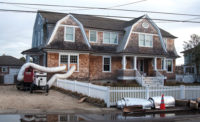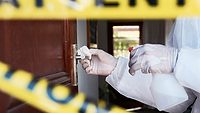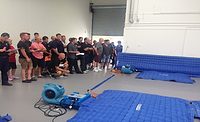Achieving Success in Restorative Drying: Key Techniques and Considerations

Photo: Michael Blann / DigitalVision via Getty Images
The Goal of Restorative Drying
Restorative drying consists of returning building materials and components to pre-determined condition quickly, efficiently and cost-effectively. An essential step of the restorative drying process is to consider the materials and cost. Some building and floor materials may be permanently damaged after direct contact with water (depending on the material makeup and category of water). You should also factor in the material's immediate pre-loss condition when considering the restorability of flooring and other building materials. Is the cost of replacement less than the cost of restoring? In most cases, restoration is not only less expensive, but also faster than replacement. However, there are exceptions.
Critical Aspects of Restorative Drying
Restorative drying is the first step in drying any structure. It has a huge impact on the overall drying time if you place emphasis on the extraction. In addition to carpet (padding), wood floors, subfloors, and tile floor assemblies can be extracted. This is the first step to success when drying building components. Once the extraction is complete and drying equipment installed, verification of drying progress will lead you through the remainder of the job.
As our industry matures and the awareness of indoor air quality (IAQ) increases, ensuring fast and complete drying becomes more and more important. Air movement/evaporation are critical in the equation of changing water into a vapor. Reducing humidity and maintaining temperature of the air as well as the materials increases vapor pressure differentials of materials and increases evaporation.
Dehumidification reduces the water vapor content of the air. There are various dehumidifiers available today and can even record information via remote monitoring and Bluetooth application. Properly managing the temperature within a structure is critical to ensure the drying of wet building materials and allows dehumidifiers to work efficiently. The restorer should consider that temperature affects building materials rate of evaporation.
In order to properly dry building materials, the restorer should be educated on the building assembly and temperature limits.
The Inspection
To properly perform the inspection, the restorer needs to instill patience when inspecting the structure. Where did the water migrate? Consider that water seeks a path of least resistance and therefore materials that are out of sight are out of mind (and not inspected) and remain undiscovered.
The restorer should quantify how wet materials are and establish drying standards and goals for each affected material. Understanding the permeability of materials needs to be established as not all materials are the same. Materials that are highly permeable absorb and release water easier than semi/non permeable materials do. Theses materials will have a longer evaporation rate and may require a different drying strategy (e.g., the warmer the liquid in the material, then the better the rate of evaporation).
With the advent of vendor programs and third party administrators (TPAs) ever increasing, the demand for documentation and verification climbs the ladder of importance. This is not only to satisfy client requests, but also limits our own liability. One major complaint in our industry is the lack of documentation considering the apps, digital, and other electronic software available today. If a job that your firm handles today goes to court in two years, what defense will you have without a complete and detailed documentation of your drying results?
We work in a service industry, and part of that service is documenting that we accomplished what we were hired to do. Additionally, we can't make decisions about what needs to be replaced, what can be restored and how to save it if we do not know what moisture is doing within the structure. The instrumentation necessary to perform proper monitoring consists of four basic types: penetrating moisture meters, non-penetrating moisture meters, thermo-hygrometers and moisture sensors. Additional tools are necessary to access certain areas of the structure, but these are the instruments that should be in your kit.
Penetrating moisture meters are the most accurate at pinpointing moisture in a structure. When used in conjunction with insulated pins, moisture can be located with great accuracy in terms of the moisture percentage and exact location. When comparing these readings from day to day, moisture can actually be tracked as it moves through materials.
Non-penetrating moisture meters are accurate in terms of moisture content percentage, but they cannot locate the depth of the moisture. Additionally, they are limited in performance by thicker materials that they are unable to take readings through. However, they are very effective at monitoring surfaces that a penetrating meter would visibly damage.
When using non-penetrating moisture meters, you need to consider the limitation of depth. Most are set to read 1/2" to 5/8" and will not detect moisture any deeper. If the material you are inspecting is thicker than that, a penetrating reading should be done to verify drying. Moisture sensors and infrared cameras display surface temperatures that aid in the inspection (followed by moisture meters) and are great tools for determining the initial boundaries of water migration at a job. Sensors do not tell you how much water is present–just that materials are wet or dry. Due to this limitation, they cannot be used to monitor progress. Progress can only be measured through quantification. If you cannot verify progress with numbers, the job can become disastrous very quickly. Projects should be monitored on a daily basis to adjust and modify the drying capacity as needed. This process should continue until verification and documentation justify that materials are dry.
Change is a constant and is an opportunity to set yourself apart from the competition. Repetition makes reputation, so apply the art of restorative drying on each project to enhance your abilities to serve your customers at a higher level.
Looking for a reprint of this article?
From high-res PDFs to custom plaques, order your copy today!





